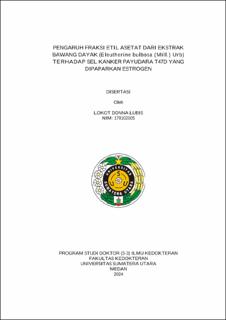| dc.contributor.advisor | Siregar, Muhammad Fidel Ganis | |
| dc.contributor.advisor | Farhat | |
| dc.contributor.advisor | Nasution, Iqbal Pahlevi Adeputra | |
| dc.contributor.author | Lubis, Lokot Donna | |
| dc.date.accessioned | 2024-08-01T02:56:49Z | |
| dc.date.available | 2024-08-01T02:56:49Z | |
| dc.date.issued | 2024 | |
| dc.identifier.uri | https://repositori.usu.ac.id/handle/123456789/94617 | |
| dc.description.abstract | Background: Breast cancer is the most common cause of cancer death in women and the fifth leading cause of all cancer deaths. In Indonesia, the high incidence of breast cancer is also accompanied by a low rate of treatment success because around 70% of sufferers visit a doctor or hospital at an advanced stage. Lack of knowledge and socio-cultural conditions of sufferers cause delays in breast cancer treatment and prevention. From several previous studies, Dayak onions are known to have potential activity as an anticancer plant against breast cancer, colon cancer and leukemia.
Objectives: To evaluate the effect of the ethyl acetate fraction of Dayak onion extract on T47D breast cancer cell cultures exposed to estrogen.
Methods: Dayak onion bulbs were collected from Pancur Batu Regency, North Sumatra Province, Indonesia. Various solvents are used for extraction and analysis of phytochemical compounds through chemical reactions, thin layer chromatography (TLC) profiling, and Fourier Transform Infrared Spectrophotometer (FTIR) profiling. Then a cytotoxicity test was carried out, a cell cycle progression inhibition test using the PI/RNase marker, a G1 phase cell cycle inhibition test using the Cyclin D1 marker, a G1-S phase cell cycle inhibition test using the Cyclin E marker, an apoptosis induction test using the Annexin V and Caspase 3 markers. All evaluation of the anticancer effect used flow cytometry. Results: The ethyl acetate fraction of Dayak Onion extract contains flavonoids and glycosides. The results of the cytotoxicity test by the MTT method with an IC50 value of 66,850 μg/ml. PI RNAase staining showed that the ethyl acetate extract fraction did not affect the cycle progression of T47D breast cancer cells exposed to estrogen in the G1 and G2/M phases but affected the G1/S phase. It also did not affect the expression of cylin D1. The ethyl acetate fraction of the extract has the ability to inhibit cylin E expression which affects cell proliferation in the G1/S phase. The ethyl acetate fraction from the extract also induces apoptosis in T47D cells detected by with anexin V expression, but the caspase 3 expression were not increase.
Conclusion: From this study, it can be concluded that the ethyl acetate fraction of Dayak onion extract has potential as an anticancer agent by inhibiting the progression of the G1/S phase cell cycle, reducing Cyclin E expression and having the ability to induce apoptosis by increasing cells undergoing apoptosis through Anexin V staining. | en_US |
| dc.language.iso | id | en_US |
| dc.publisher | Universitas Sumatera Utara | en_US |
| dc.subject | Dayak Onions | en_US |
| dc.subject | Extract | en_US |
| dc.subject | Ethyl Acetate | en_US |
| dc.subject | Breast Cancer | en_US |
| dc.subject | SDGs | en_US |
| dc.title | Pengaruh Fraksi Etil Asetat dari Ekstrak Bawang Dayak (Eleutherine bulbosa (Mill.) Urb) terhadap Sel Kanker Payudara T47D yang Dipaparkan Estrogen | en_US |
| dc.title.alternative | Effect of Ethyl Acetate Fraction from Dayak Onion Extract (Eleutherine bulbosa (Mill.) Urb) on T47D Breast Cancer Cells Exposed to Estrogen | en_US |
| dc.type | Thesis | en_US |
| dc.identifier.nim | NIM178102005 | |
| dc.identifier.nidn | NIDN0030056407 | |
| dc.identifier.nidn | NIDN0016037002 | |
| dc.identifier.nidn | NIDN0021077308 | |
| dc.identifier.kodeprodi | KODEPRODI11001#Ilmu Kedokteran | |
| dc.description.pages | 216 Pages | en_US |
| dc.description.type | Disertasi Doktor | en_US |


